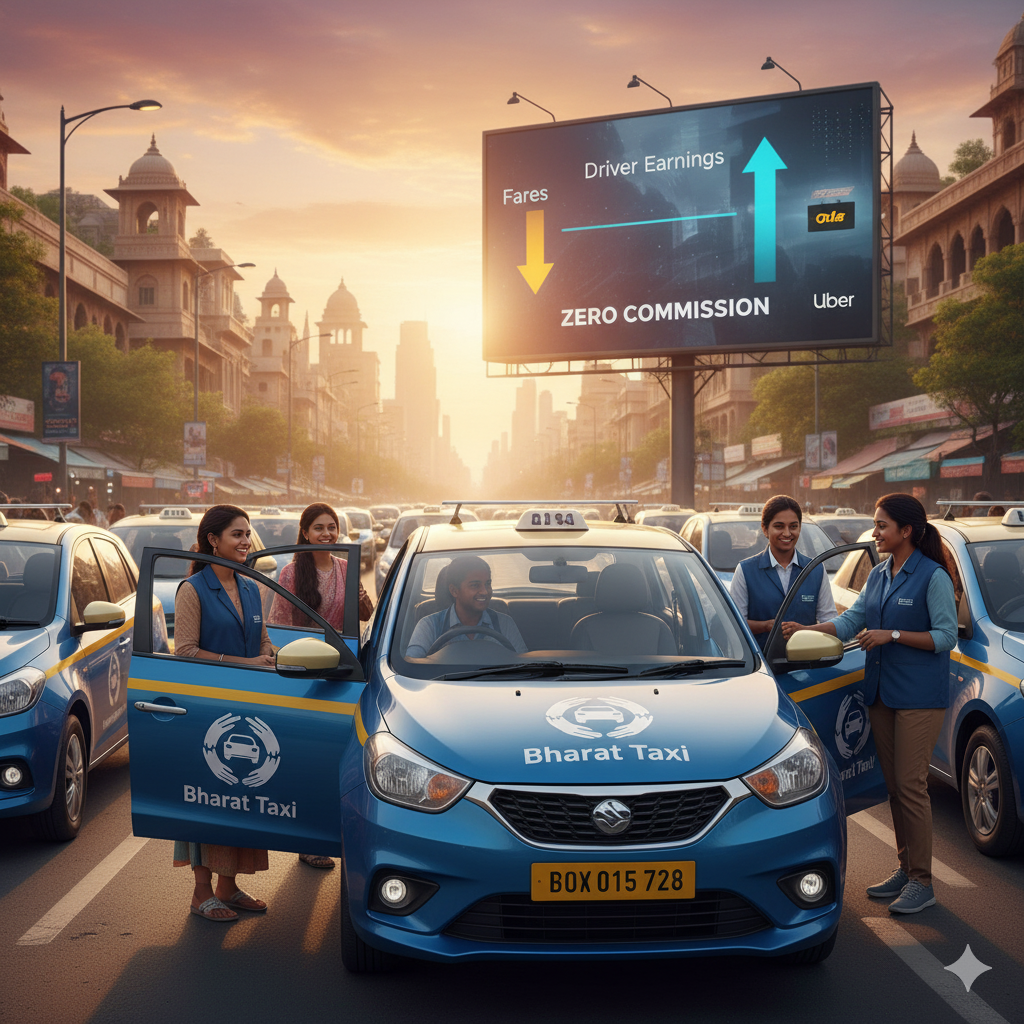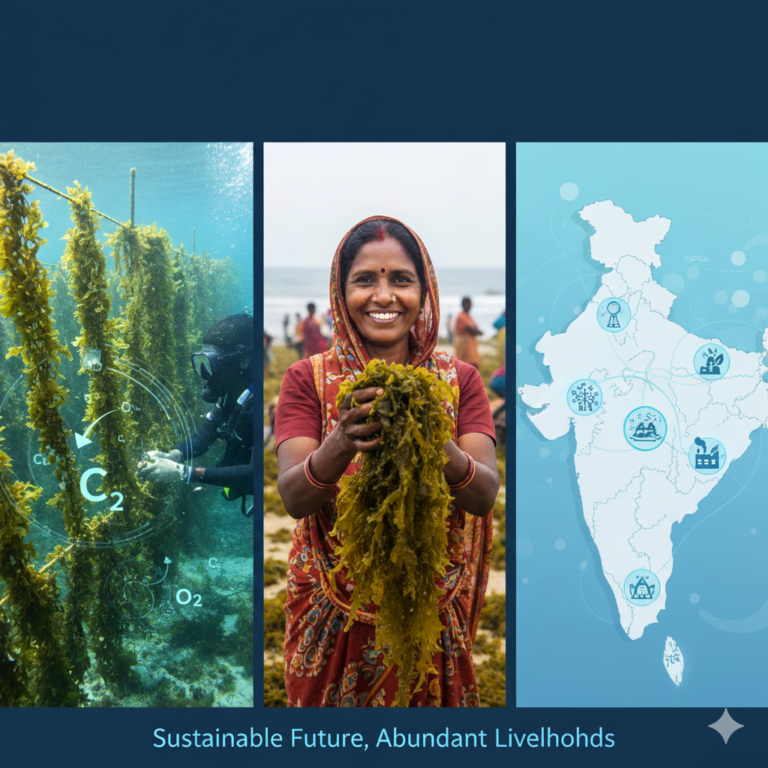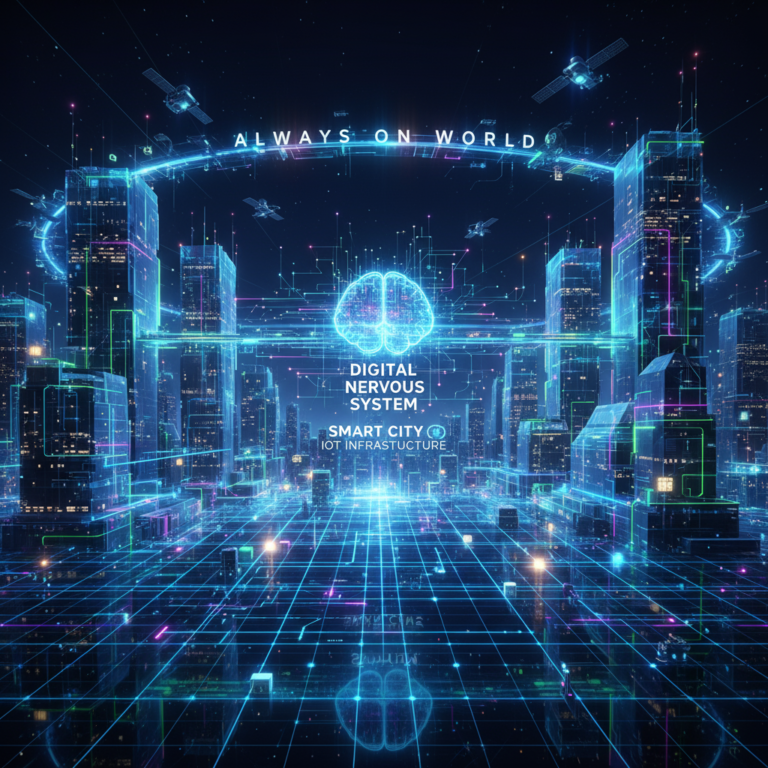Key Highlights
- Historic Launch: Bharat Taxi launching December 2025 as India’s first national cooperative-driven ride-hailing platform backed by NeGD, MeitY, challenging Uber/Ola with driver ownership model
- Institutional Muscle: ₹300 crore authorized capital with ₹80 crore committed by 8 major cooperatives (NCDC, IFFCO, AMUL, KRIBHCO, NAFED, NABARD, NDDB, NCEL) – ₹10 crore each
- Driver Empowerment: Drivers become co-owners purchasing 5 shares @ ₹100 after 6 months service; participate in profit-sharing, governance decisions, and social security benefits
- DPI Integration: Seamless integration with DigiLocker, UMANG, API Setu enabling identity verification, license validation, paperless onboarding, UPI payments
- Transparent Pricing: Open-source fare algorithms preventing surge pricing manipulation; fair pricing for passengers while ensuring driver dignity and stable income
The Genesis: Why India Needs a Cooperative Ride-Hailing Alternative

In a world dominated by global ride-hailing giants extracting commissions up to 25-30% while leaving drivers with precarious incomes and no stake in platforms they power, India is charting a radically different course rooted in cooperative values, democratic ownership, and technology-enabled inclusion. thesecretariat
The Problem with Current Models
Driver Exploitation: Uber and Ola drivers work as contract laborers with no ownership, facing algorithmic wage manipulation, unpredictable surge pricing, high commissions, and zero social security.
Passenger Frustration: Surge pricing during peak demand can multiply fares 3-5x; opaque algorithms determine pricing without accountability; customer grievance redressal often inadequate.
Concentrated Control: Platform profits flow to corporate shareholders and foreign investors rather than communities and workers generating value.
The Cooperative Alternative
Union Home and Cooperation Minister Amit Shah’s vision: “Every taxi driver will not just be connected to the service, but will be the owner of the cooperative taxi. This is the power of the cooperative model.”
Three Foundational Principles:
- Fair Pricing: No surge pricing manipulation; transparent fare algorithms benefiting both drivers and passengers
- Profit Redistribution: All earnings redistributed among driver-members with portion allocated for social security
- Social Protection: Medical support, retirement plans, long-term wellbeing provisions
Institutional Architecture: Cooperative Powerhouses Unite

Bharat Taxi (officially Sahakar Taxi Cooperative Limited) was registered under the Multi-State Cooperative Societies Act, 2002 in June 2025 – enabling operations across multiple states without bureaucratic bottlenecks that plague traditional cab aggregators. SahakarTaxi
The Eight Promoter Institutions
Financial Commitment: Each pledged ₹10 crore, totaling ₹80 crore out of ₹300 crore authorized capital
1. National Cooperative Development Corporation (NCDC): Leading promoter providing governance expertise
2. Anand Milk Union Limited (AMUL): India’s dairy cooperative giant demonstrating cooperative model’s transformative potential
3. National Agricultural Cooperative Marketing Federation (NAFED): Agricultural marketing expertise
4. National Bank for Agriculture and Rural Development (NABARD): Financial infrastructure and rural reach
5. Indian Farmers Fertiliser Cooperative (IFFCO): Cooperative principles and farmer connections
6. Krishak Bharati Cooperative (KRIBHCO): Agricultural input cooperative experience
7. National Dairy Development Board (NDDB): Dairy cooperative development expertise
8. National Cooperative Exports Limited (NCEL): Export and marketing capabilities
Governance Structure
- Rohit Gupta (NCDC Deputy MD): Chairman
- V Sridhar (NDDB)
- Tarun Handa (NAFED)
- Naveen Kumar (NABARD)
- Santosh Shukla (IFFCO)
- LP Godwin (KRIBHCO)
Office: 2nd Floor, East Wing, NCDC, 4 Siri Institutional Area, Hauz Khas, New Delhi 110016
Registration: MSCS/CR/1629/2025 under Multi-State Cooperative Societies Act, 2002 bharattaxiapp
NeGD Partnership: Digital India’s Strategic Support
On October 7, 2025, NeGD (National e-Governance Division) under Ministry of Electronics & IT formalized MoU with Sahakar Taxi Cooperative Limited providing strategic advisory and technical support.
NeGD’s Four-Pillar Support Framework

1. Platform Integration & Technical Architecture:
- Integration with DigiLocker for document verification
- UMANG (Unified Mobile Application for New-age Governance) connectivity
- API Setu interoperability for seamless government services
- Aadhaar identity authentication
- UPI digital payment infrastructure
2. Security, Compliance & Infrastructure:
- Adherence to Government of India data protection norms
- Robust cybersecurity standards implementation
- Technical infrastructure strengthening
- Privacy-by-design architecture
3. Governance & Programme Management:
- Policy guidance based on NeGD’s experience with large-scale national platforms
- Transparent, accountable operational frameworks
- Programme monitoring and evaluation
- Multilingual interfaces ensuring nationwide usability
- Inclusive access features for differently-abled users
- Citizen-friendly design for both urban and rural populations
- Women driver participation encouragement
The Driver Ownership Model: Dignity Through Ownership

What distinguishes Bharat Taxi from Uber/Ola isn’t just technology – it’s ownership structure that transforms exploitation into empowerment.
Membership Pathway
Initial Onboarding: 200-400 drivers already onboarded across Delhi, Gujarat, Maharashtra, Uttar Pradesh pib.gov
Six-Month Probation: Drivers work as service providers learning platform operations
Cooperative Membership: After 6 months, drivers can purchase 5 shares @ ₹100 each (total ₹500) becoming full cooperative members
Ownership Rights: Voting on platform policies, fare structures, expansion strategies; participation in annual general meetings; access to social security benefits
Economic Model: Fair Distribution
Transparent Commission Structure: Low-fee model ensuring drivers retain maximum earnings versus 20-30% commissions charged by private platforms
Profit Redistribution: All platform surplus distributed among driver-members proportionate to their contribution and shareholding
Social Security Fund: Portion of earnings allocated for:
- Medical insurance and healthcare support
- Accident coverage
- Retirement benefits
- Educational support for children
- Emergency financial assistance
No Surge Pricing: Fixed, transparent fare structure preventing passenger exploitation during peak demand while ensuring stable driver income
Technology Stack: Digital Public Infrastructure Advantage
Bharat Taxi’s integration with India’s Digital Public Infrastructure (DPI) stack provides competitive advantages global platforms cannot replicate.
DigiLocker Integration
Purpose: Paperless document verification enabling instant driver onboarding
Benefits: Driving license validation, address proof verification, vehicle registration confirmation – all digitally without physical documentation hassles
User Experience: Passengers confident in driver identity verification through government-backed authentication
UMANG Platform Connectivity
Purpose: Single-window access to government services
Benefits: Seamless integration with transport department systems, digital challan payments, license renewals, vehicle-related services
Driver Advantage: Complete transport ecosystem accessible through single platform
API Setu Interoperability
Purpose: Standardized API framework enabling government service integration
Benefits: Real-time data exchange with traffic management systems, public transport coordination, emergency services
Future Potential: Integration with metro schedules, bus routes, railway bookings creating comprehensive mobility ecosystem
Aadhaar-Based Authentication
Purpose: Biometric identity verification
Benefits: Fraud prevention, passenger safety, driver accountability, dispute resolution
Trust Building: Government-backed identity assurance addressing safety concerns plaguing ride-hailing sector
UPI Payment Integration
Purpose: Digital payment infrastructure
Benefits: Cashless transactions, instant settlements, transparent payment trails, reduced cash handling risks
Financial Inclusion: Enabling drivers to build digital financial profiles for credit access
Operational Blueprint: From Pilot to National Scale
Initial Geographic Rollout
December 2025 Launch Locations:
- Delhi NCR: Capital city with massive ride-hailing demand
- Gujarat: Strong cooperative movement tradition
- Maharashtra: Mumbai’s huge market potential
- Uttar Pradesh: Large population base and connectivity needs
Expansion Strategy: Gradual rollout to additional states after proving model viability and refining operations
Vehicle Categories
- Two-wheelers: Urban short-distance quick commutes
- Auto-rickshaws: Affordable urban mobility
- Hatchbacks/Sedans: Standard cab services
- SUVs: Premium and group travel
- Electric Vehicles: Sustainable mobility focus
Green Mobility: Support for EV and CNG vehicles through partnerships with government schemes
Technology Development
Academic Partnerships: Collaborations with institutions like International Institute of Information Technology, Bengaluru for technological development, operational systems, digital integration matching industry standards
Open-Source Philosophy: Transparent fare algorithms enabling public scrutiny and preventing manipulative practices
Continuous Innovation: Platform evolution based on user feedback and cooperative member input
Socio-Economic Impact: Beyond Mobility
Gig Economy Reform
Transforming Precarity into Security: Bharat Taxi addresses fundamental gig economy challenges – income instability, lack of benefits, no voice in platform governance
Labor Code Alignment: Model aligns with recent labor code reforms recognizing platform workers’ rights to social security and collective bargaining
Replicable Framework: Success could inspire cooperative models in food delivery, logistics, home services sectors
Rural Mobility Enhancement
Last-Mile Connectivity: Platform designed for urban and rural areas, improving transportation access in remote/hilly regions underserved by traditional services
PACS Integration: Union Minister Amit Shah highlighted potential engagement of Primary Agricultural Credit Societies (PACS) with cooperative taxi services, strengthening rural-urban cooperative ecosystem
Agricultural Linkages: Enabling farmers to access markets, healthcare, administrative services through affordable, reliable transport
Women’s Economic Participation
Safety and Dignity: Platform’s emphasis on verified driver identities, government-backed security, cooperative accountability addresses women’s safety concerns
Women Drivers: Inclusive design actively encouraging women’s participation as drivers – both as employment and entrepreneurship opportunity
Gender-Sensitive Features: Women-only driver options, SOS features, real-time trip sharing with family members
SDG Alignment
SDG 8 (Decent Work): Transforming gig work into decent employment with social protections
SDG 9 (Industry, Innovation, Infrastructure): Leveraging technology for inclusive industrial development
SDG 11 (Sustainable Cities & Communities): Enhancing urban mobility and public transport integration
SDG 10 (Reduced Inequalities): Democratizing platform economy benefits
Regulatory and Policy Framework
Government Role
Non-Equity Support: Government provides advisory, technical assistance, regulatory facilitation but no equity stake – preserving cooperative autonomy
Regulatory Environment: Operating under existing frameworks:
- Multi-State Cooperative Societies Act, 2002
- Digital Personal Data Protection Act, 2023
- IT Act, 2000 and intermediary guidelines
- State motor vehicle regulations
Policy Alignment:
- Digital India: Citizen-centric digital services
- Atmanirbhar Bharat: Self-reliant, locally-owned platforms
- Sahkar se Samriddhi: Prosperity through cooperation
- Viksit Bharat 2047: Developed India vision
Competitive Landscape Challenges
Market Incumbency: Uber and Ola have entrenched presence, brand recognition, technological sophistication, financial resources for subsidizing rides
Network Effects: Existing platforms benefit from large driver and passenger bases creating self-reinforcing advantages
Pricing Pressure: Private players can temporarily slash prices or offer cashbacks to prevent market share loss
Quality Consistency: Maintaining service standards while rapidly scaling membership and geographic coverage
Mitigation Strategies:
- Leveraging government DPI integration as unique value proposition
- Emphasizing ethical, transparent practices building trust over time
- Targeting underserved rural and tier-2/3 city markets first
- Building on existing cooperative networks and community trust
Challenges and Mitigation Strategies
Operational Challenges
Technology Competitiveness: Matching real-time route optimization, AI-driven demand prediction, seamless UX of established platforms
Mitigation: Academic partnerships (IIIT Bangalore), open-source collaboration, leveraging NeGD’s technical expertise
Driver Training: Ensuring quality, hospitality standards, digital literacy across diverse driver base
Mitigation: Comprehensive training programs; leveraging cooperative institutions’ grassroots reach; continuous skill development
Customer Acquisition: Breaking passenger habits and building trust in new platform
Mitigation: Introductory pricing, word-of-mouth through cooperative networks, government employee prioritization, quality emphasis over quantity
Governance Challenges
Collective Decision-Making vs. Agility: Balancing democratic processes with need for rapid decisions in dynamic market
Mitigation: Clear governance frameworks, professional management team, delegation protocols, regular but structured member consultations
Avoiding Bureaucratic Drift: Preventing inefficiencies common in legacy cooperatives
Mitigation: Lean operational structure, technology-enabled transparency, performance metrics, external audits, youth participation
Rent-Seeking Prevention: Guarding against capture by vested interests or corruption
Mitigation: Transparent incentive structures, public disclosure of decisions and finances, member vigilance, regulatory oversight
Financial Sustainability
Initial Losses: Platform economics require critical mass before profitability
Mitigation: Patient capital from cooperative promoters; prioritizing sustainability over growth-at-any-cost; cost-efficient operations
Subsidy Resistance: Avoiding unsustainable pricing that creates dependency
Mitigation: Fair pricing from day one; educating users on true costs; value differentiation on ethics, transparency, community benefit
Global Parallels: Platform Cooperativism Movement
International Examples
The Drivers Cooperative (New York): Driver-owned ride-hailing cooperative challenging Uber with 8% commission versus 25%+ industry standard
Barcelona’s Platform Cooperativism: Multiple worker-owned digital platforms across sectors demonstrating viability
Kenya’s Digital Cooperatives: Mobile-based cooperative services reaching rural populations
Lessons for Bharat Taxi
Open-Source Technology: Leveraging shared platforms reducing development costs
Driver Education: Continuous training in business literacy, technology, customer service
Legal Protections: Strong cooperative laws and platform worker rights essential
Cooperative Marketing: Emphasizing ethical consumption, community benefit, fair trade principles
India’s Advantage: Existing cooperative tradition (AMUL, credit cooperatives, dairy cooperatives) providing proven institutional frameworks and grassroots reach
Policy Recommendations for Sustained Success
Continued Technical Support: NeGD’s advisory role should extend beyond launch through iterative platform improvement
State Transport Integration: Partnerships with state transport departments for last-mile rural-urban connectivity, public transport coordination
Skilling Infrastructure: Dedicated training centers for driver skill development in digital literacy, customer service, vehicle maintenance
Research and Evaluation: Rigorous impact assessment studying cooperative model effectiveness, replicability, scalability lessons
Regulatory Certainty: Clear guidelines on platform cooperatives preventing arbitrary restrictions or discriminatory treatment versus private players
Financial Incentives: Priority access to government tenders, preferential rates for government employee usage, tax incentives for cooperative enterprises
National Rollout Support: Central government facilitation for interstate operations, uniform standards, dispute resolution mechanisms
Conclusion: Reimagining Mobility Through Cooperation

Bharat Taxi’s December 2025 launch represents far more than another ride-hailing app entering India’s crowded mobility market. It embodies a fundamental reimagining of how digital platforms can be structured – not for shareholder profit extraction but for stakeholder prosperity; not through centralized control but democratic governance; not exploiting workers but empowering them as co-owners.
The institutional backing is unprecedented: NCDC, IFFCO, AMUL, NABARD, NDDB, KRIBHCO, NAFED, NCEL – eight cooperative powerhouses committing ₹80 crore out of ₹300 crore authorized capital. These aren’t startups seeking quick exits but century-old institutions committed to long-term community welfare.
The government support is strategic: NeGD’s partnership providing Digital Public Infrastructure integration (DigiLocker, UMANG, API Setu, Aadhaar, UPI), cybersecurity frameworks, governance advisory – advantages no private platform can replicate. This positions Bharat Taxi not as competitor using same playbook but as fundamentally different model leveraging India’s unique DPI capabilities.
The driver model transforms exploitation into dignity: After 6 months, drivers purchasing 5 shares @ ₹100 become cooperative members with voting rights, profit-sharing, social security – moving from algorithmic control to democratic ownership. No surge pricing manipulation; transparent fare algorithms; stable income; medical insurance; retirement benefits – replacing precarity with security.
Challenges are formidable: Competing with deep-pocketed incumbents (Uber/Ola) possessing technological sophistication, brand recognition, network effects requires patient capital, superior service quality, and trust-building over time. Balancing collective ownership with operational agility demands governance innovation preventing bureaucratic drift common in legacy cooperatives.
Bharat Taxi offers rich analytical terrain: How can democratic principles be applied to digital platforms? Can cooperatives succeed in tech-intensive, fast-moving sectors? What regulatory frameworks enable platform cooperativism without stifling innovation? How does India’s DPI stack provide competitive advantages? Can ethical, inclusive business models outcompete extractive capitalism?
It’s success or failure will shape India’s digital economic future: If it succeeds, the cooperative model could spread to food delivery, logistics, home services, healthcare – democratizing the entire gig economy. If it struggles, the platform economy may remain dominated by concentrated corporate power extracting value from millions of workers who power it.
The launch is merely the beginning of a live experiment in building public interest technology – technology that serves citizens not as products to be monetized but as stakeholders to be empowered; that distributes platform prosperity to those creating value; that demonstrates alternatives to surveillance capitalism and algorithmic exploitation.









+ There are no comments
Add yours